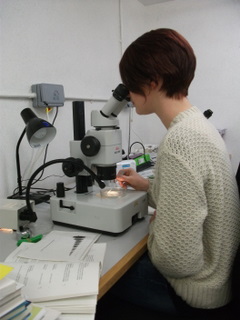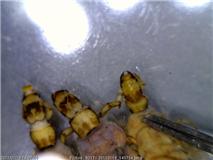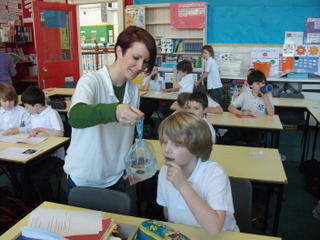 Hi all!
Hi all!
It’s nearly February… where does the time go? Well I can tell you, for the headwater’s apprentice I have been methodically working my way through a bundle of invertebrate Surber samples, and by a bundle I mean approximately 140! Now sorting samples as its best known… but what’s that saying…”separating the wheat from the chaff?” or in other words removing once living invertebrates from all the crud you’ve kicked or clawed from the bottom of a river – literally painful but essential. What you’ve got to understand is that to get what seems like a small insignificant piece of information about some insects, there’s actually a lot of time and hard work goes into it. So post sorting is the identification, which I had been looking forward to, swapping my white tray for a microscope! To date I have identified all my surber samples from the Elvan River and the Glengonnar, my control site and metal contaminated site, respectively. It’s slow at first as species identification is tricky. When identifying my first limnephilidae (Cased-caddis) to species level, I thought, when is this going to end? So many pages! Zooming in on something’s mandibles, has it got teeth, just one tooth or no teeth?! AAAAAH! What I’ve learned is to accept that sometimes things are just not developed enough to identify, and instead of wasting time quivaling over whether a mayfly is Ecydonurus dispar or torrentis to just record the genus spp. and move on. DONE! It’s better to be sure you have the genus correct than to have a guess at the species without being sure! What I’ve noticed in some of the Glengonnar samples is that many of the invertebrates have an orange deposit on their outer surface or in their insides, this is absent in the Elvan ones. Ochre perhaps! Also I’ve tried to mix it up a bit by starting some of the Abington Windfarm samples, so I’ve got something new to look at and learn to identify. My most interesting find is the possibility of having all three UK species of Rhyacophilidae in a tiny burn, the Wandel burn. I’ve taken some close up shots of their features and I’m going to send them off to Ian Wallace, caddis expert and one of the authors of the FBA key.

Most excitingly next week I’m heading down to University College London, to go on their Introduction to Diatom Identification course. I really can’t wait! It’s a NERC recognised course, so it’ll be really good to have under my belt so to speak. I’m going to take my slides of mounted diatoms from my two rivers and hopefully learn how to identify them, as they offer personal tuition sessions. This will be really good as when I visited SEPA in Aberdeen, the identification process was described to me as a little like a game of SNAP! I don’t know why I didn’t make a run for it then and there! Really the only thing I’m finding daunting is going alone and travelling around London. Originally two PhD students were meant to be going as well but they didn’t book in time. But these things are never as bad as you think they’re going to be!

The Clyde River Foundation is in full swing with their education programme, “Clyde in the Classroom” and in between ID I’ve been lending a hand with that. They’ve had several launch days at Glasgow Science Centre, where I’ve gone along to take photos and videos of the kids having fun and learning about fish and how to look after their trout eggs. Adult brown trout often swim right up to the headwaters where the female will lay up to 3000 eggs, of which only 2 may survive, just enough to sustain the population! WOW! In addition I’ve helped with the installation of the fish tanks in the participating primary schools and also the delivery of the eggs just this week. Some of the questions have been just great such as, “Do fish have ears?” “Why are fish so important to us?” and “why do the dead fish eggs turn white?” Has made me want to go back to primary school and ponder (if only briefly) would I want to be a primary teacher perhaps?!
So to the next few months I will continue to be involved with Clyde and the Classroom, visiting the classes to see how they’re progressing, plan my spring sampling season, and carry on with my invertebrate ID and not forgetting my pretty little diatomaceous algae!
Chao for now!
Lesley
